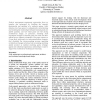1636 search results - page 83 / 328 » Using Bayesian Networks to Model Agent Relationships |
RE
2001
Springer
14 years 4 days ago
2001
Springer
Today's requirements engineering approaches focus on notation and techniques for modeling the intended functionality and qualities of a software system. Little attention has ...
BMCBI
2010
13 years 2 months ago
2010
Background: Differential co-expression analysis is an emerging strategy for characterizing disease related dysregulation of gene expression regulatory networks. Given pre-defined ...
ACOM
2006
Springer
14 years 1 months ago
2006
Springer
In this research, we re-arrange FIPA’s ACL performatives to form a subsumption lattice (ontology) and apply a theory of social commitments to achieve a simplified and observable...
ICML
2008
IEEE
14 years 8 months ago
2008
IEEE
We present a principled Bayesian framework for modeling partial memberships of data points to clusters. Unlike a standard mixture model which assumes that each data point belongs ...
CVPR
2008
IEEE
14 years 9 months ago
2008
IEEE
Graphical models such as Bayesian Networks (BNs) are being increasingly applied to various computer vision problems. One bottleneck in using BN is that learning the BN model param...

